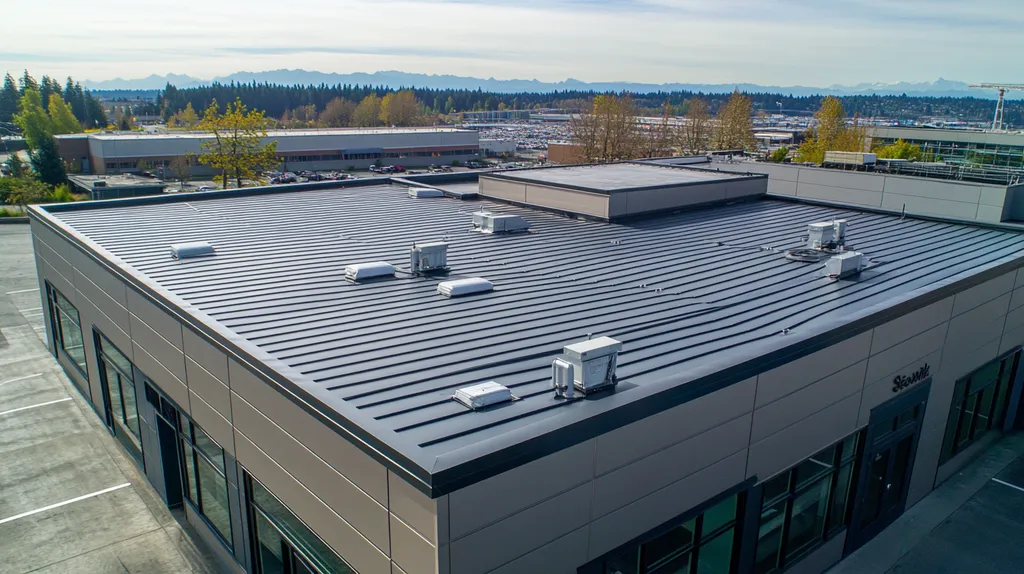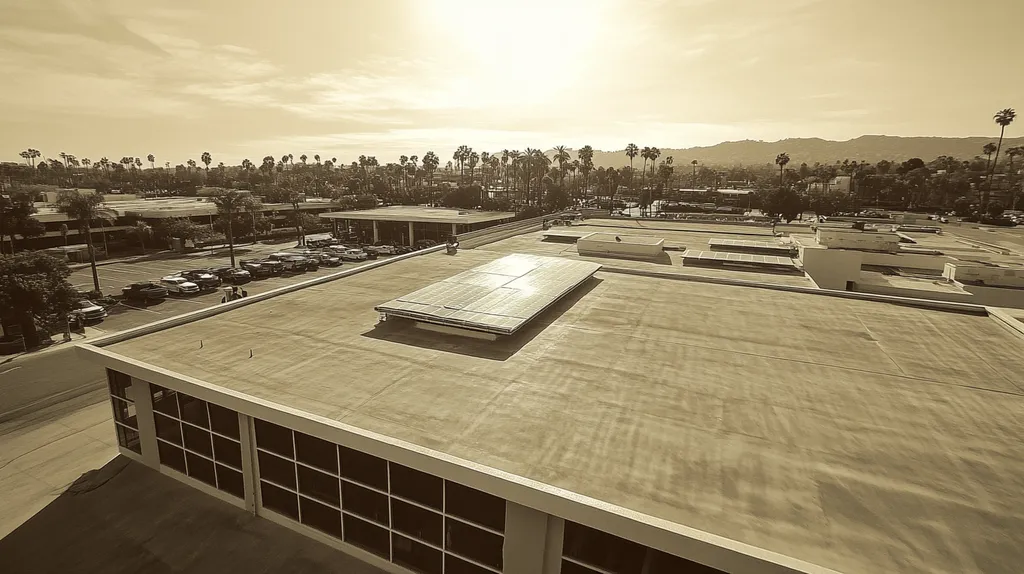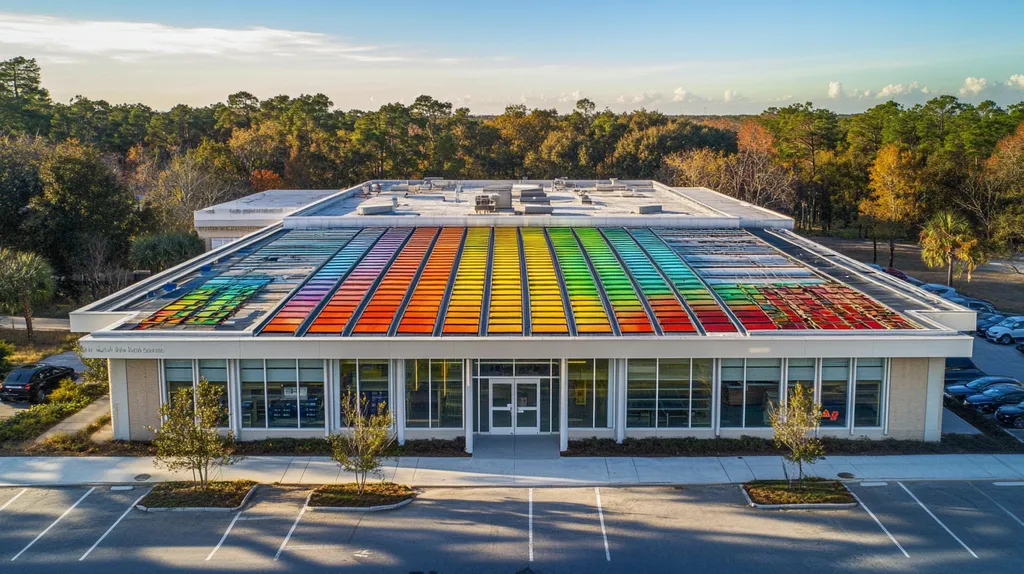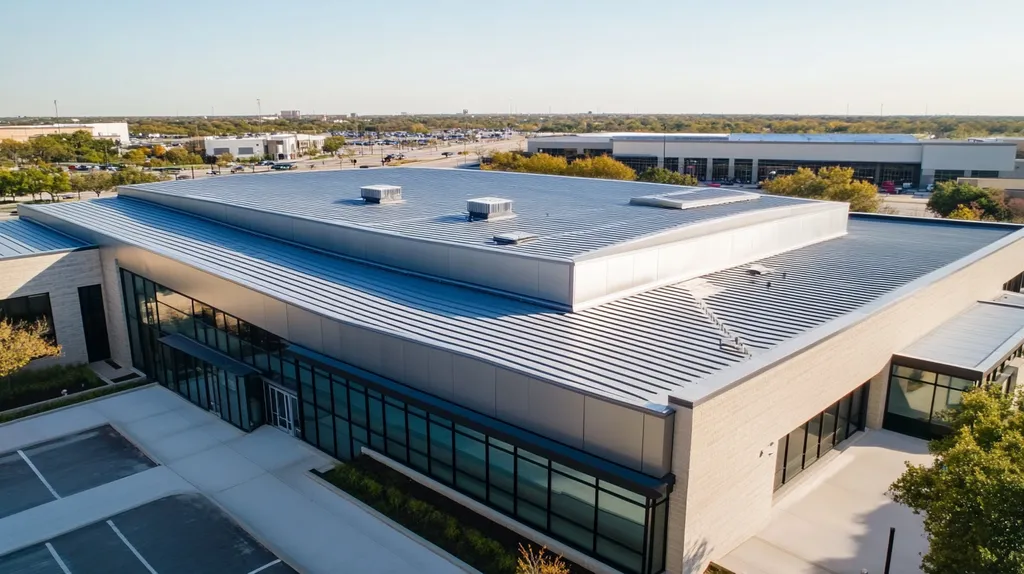With commercial buildings accounting for nearly 40% of U.S. energy consumption, the efficiency of roofing systems has become a critical factor in controlling operational costs. Studies show that optimized commercial roofs can reduce energy expenses by up to 30% annually.
Yet most facility managers struggle to navigate the complex landscape of roofing technologies, compliance requirements, and maintenance protocols that impact energy performance.
This comprehensive guide provides actionable solutions for enhancing roof energy efficiency, from selecting climate-appropriate materials to implementing preventive maintenance strategies that protect long-term investments.
SECTION 1: PERFORMANCE FACTORS
Energy efficiency in commercial roofing is essential for managing overhead costs and enhancing sustainability. With buildings consuming nearly 40% of total energy in the U.S., optimizing roofing systems isn’t just smart—it’s vital. This section delves into key performance factors such as the harmony between roof type and climate, the effectiveness of heat reflection and insulation, and durability against severe weather.
Climate and Roof Type Compatibility
Choosing the right roofing type based on local climate is crucial for energy efficiency. For example, flat roofs can thrive in dry regions, while sloped roofs excel in areas prone to heavy rainfall. By understanding local weather patterns, facility managers can make informed choices that greatly reduce the chances of expensive repairs or early replacements.
Materials like TPO and EPDM are gaining traction in warmer climates due to their strong resistance to UV rays and heat. On the other hand, built-up roofs provide excellent protection in cooler regions by reflecting cold air and helping minimize heating costs.
Facility managers should also consider the expected lifespan and warranty of roofing materials. Selecting a roof that syncs with local climate conditions can enhance energy efficiency significantly, extending the roof’s longevity and cutting overall operational costs.
Key Action Items
Heat Reflection and Insulation Efficiency
Reflective roofing materials can significantly reduce energy consumption. For instance, white or light-colored roofs can reflect up to 85% of sunlight, keeping interiors cooler and less reliant on air conditioning. This reduction in cooling needs can lead to substantial cost savings during hot months.
Effective insulation is equally critical. It minimizes heat loss in winter months and helps maintain cooler interiors in the summer. This dual benefit means a well-insulated roof not only enhances energy efficiency but also maximizes comfort for building occupants.
Facility managers should ensure insulation levels meet current energy codes and are properly maintained. Utilizing advanced insulation materials can further boost both energy performance and comfort, allowing for significant long-term savings.
Key Action Items
Durability Against Weather Extremes
Extreme weather can pose serious challenges for roofing systems. High winds, heavy snowfall, and extreme heat can threaten roof integrity and compromise energy efficiency. Selecting durable roofing materials is a proactive step in mitigating these risks and ensuring long-term performance.
For instance, metal roofs excel in harsh climates, resisting high winds and hail while also providing excellent heat reflection. Additionally, materials with low thermal conductivity can help maintain stable indoor temperatures year-round, further enhancing energy efficiency.
Understanding the weather risks specific to a region allows facility managers to choose materials with suitable warranties and performance ratings. This foresight can significantly reduce emergency repair needs and extend the lifespan of the roofing system.
Key Action Items
SECTION 2: FINANCIAL CONSIDERATIONS
Facility managers are under constant pressure to balance cost management with the imperative to enhance energy efficiency. Understanding the financial implications of roofing investments is crucial. A commercial roof is more than just a protective barrier; it has a direct impact on operational costs and energy consumption. By analyzing upfront costs and long-term savings, facility managers can make informed and sustainable roofing decisions.
Upfront Costs and Long-Term Savings
Upfront costs can often be intimidating when exploring new roofing options. While traditional materials may have lower initial prices, they frequently lack the energy-efficient benefits that more advanced systems offer. Investing in high-performance roofing requires a more considerable initial outlay but can repay that investment through substantial savings down the line.
For example, a standard roof might cost around $7 per square foot, while a cool roofing system might be priced at $10 per square foot. However, the latter can lower energy bills by up to 30%. Evaluating the long-term financial benefits rather than focusing solely on short-term expenses is essential.
Furthermore, certain roofing solutions qualify for tax credits and rebates, which can make energy-efficient roofing even more financially appealing. Balancing the initial investment against ongoing savings allows facility managers to identify roofing systems that pay for themselves over time.
Key Action Items
Energy Bill Reduction Analysis
Energy expenses make up a substantial portion of a facility’s operational budget, so analyzing potential reductions in energy bills is essential. A comprehensive examination of how roofing investments affect energy usage can strongly support financial decisions. Cool roofs, which reflect sunlight, help lower roof temperatures and reduce the need for extensive cooling.
On average, facilities with cool roofs see a 20% to 30% reduction in cooling costs. In large buildings, these savings can amount to thousands of dollars annually. By calculating current energy expenses and projecting future savings, facility managers can build a strong case for their roofing investment choices.
Additionally, considering the lifespan and warranties of roofing materials encourages a more accurate assessment of overall maintenance costs. An energy-efficient roof can lower these needs and provide long-term savings, showcasing energy savings as a vital component of a positive return on investment.
Key Action Items
ROI on Cool Roofing Investments
Understanding the return on investment (ROI) for cool roofing solutions is crucial yet often overlooked. Cool roofs enhance a building’s energy efficiency, which significantly affects the overall budget. To accurately determine ROI, both immediate and long-term savings must be evaluated.
Studies show that cool roofs can yield a return of approximately 3-5 times the initial investment over their lifespan, considering energy savings, longevity, and tax benefits. Facility managers can use these insights to align roofing upgrades with broader financial aims.
Moreover, cool roofs lead to improved indoor comfort, which can increase employee productivity and satisfaction. While these quality-of-life benefits are harder to quantify, they add significant value to the overall investment analysis, reinforcing the rationale for moving beyond traditional materials.
Key Action Items
SECTION 3: COMPLIANCE REQUIREMENTS
In today’s landscape, ensuring the energy efficiency of a commercial roof is a critical requirement rather than a choice. With growing regulations enforcing stricter standards, businesses must recognize the financial and operational risks tied to compliance. Many jurisdictions have established energy codes mandating specific performance criteria for roofing systems. By grasping these compliance requirements, facility managers can both protect their investments and boost overall roof effectiveness.
Meeting Local and International Standards
Adhering to local and international standards is essential in any commercial roofing endeavor. These standards outline performance expectations related to energy efficiency, durability, and safety. For example, the International Energy Conservation Code (IECC) provides minimum requirements for energy-efficient building envelopes, including roofs.
Non-compliance can incur costly fines and project delays. To avoid these pitfalls, facility managers must stay updated on evolving codes, ensuring roofing systems align with current regulations. Additionally, exceeding minimum compliance often brings financial incentives, motivating businesses to improve energy efficiency.
Careful monitoring of compliance is crucial during installation and maintenance. Some projects may require independent inspections to verify adherence to regulations, ensuring that energy savings and operational efficiency are realized as intended.
Key Action Items
Sustainability and Environmental Regulations
The call for sustainability makes it vital for facility managers to understand environmental regulations impacting commercial roofing. Local authorities often establish guidelines aimed at reducing carbon footprints and encouraging eco-friendly practices. For instance, achieving LEED (Leadership in Energy and Environmental Design) certification can incentivize energy-efficient roofing choices that utilize sustainable materials.
By selecting compliant materials, businesses can not only adhere to regulations but also appeal to environmentally conscious clients and stakeholders. Additionally, energy-efficient systems typically lead to lower maintenance and operational expenses, positively affecting the bottom line.
Failure to maintain compliance can result in penalties and project delays. Therefore, facility managers should actively track relevant laws regarding roofing and sustainability, ensuring their roofs satisfy necessary environmental standards.
By effectively integrating sustainable practices into roofing strategies, organizations can achieve significant energy reductions, benefiting both the facility and the environment.
Key Action Items
Safety Standards for Specific Applications
Adhering to safety standards specific to roofing applications is crucial to protect workers and the building itself. Regulatory bodies like OSHA (Occupational Safety and Health Administration) provide guidelines that enhance worker safety during installation and maintenance activities. Ensuring compliance can minimize the risk of injuries and potential legal challenges.
For instance, flat roofing systems may present unique hazards and require specific safety measures, such as fall protection protocols and proper access equipment. Prioritizing staff training in these safety standards fosters a secure working environment.
Additionally, disregarding safety compliance can lead to increased insurance premiums and greater liability risks. Understanding and implementing these safety codes is essential for planning and executing roofing projects, focusing on risk reduction and ensuring workplace safety.
Incorporating safety compliance into project planning not only safeguards employees but also demonstrates an organization’s commitment to responsible management.
Key Action Items
SECTION 4: RISK MANAGEMENT
Effectively managing risks associated with commercial roofing is essential for maintaining both the longevity and energy efficiency of a building. Alarmingly, about 40% of roofs fail prematurely due to heat damage and severe weather. Facility managers must proactively address risks stemming from heat accumulation, storm impacts, and structural integrity to safeguard their investments and optimize energy efficiency. Recognizing these risks is the first step toward informed and strategic roofing decisions.
Identifying Potential Damage from Heat and Storms
Heat and storms are top foes for commercial roofs, often resulting in leaks and decreased energy efficiency. Rising temperatures increase the risk of thermal expansion, causing seams to weaken and pull apart. Heavy rainfall or storm debris can worsen these vulnerabilities, leading to costly repairs.
To counteract these dangers, property owners should consider reflective roofing materials that minimize heat absorption, significantly lowering rooftop temperatures and energy costs while extending the roof’s lifespan. Additionally, conducting regular inspections before storm seasons is vital for identifying and addressing any potential weaknesses.
Implementing a proactive maintenance schedule—addressing debris removal and ensuring proper drainage—can drastically reduce the risk of water pooling, which often leads to more extensive structural issues. Monitoring weather patterns and utilizing weather-resistant materials further mitigates these unpredictable climate-related risks.
Key Action Items
Preventing Water Ponding and Leaks
Water ponding on commercial roofs leads to premature wear and can damage both structure and insulation. If unchecked, this issue can escalate into significant leaks, resulting in costly internal damage and increased energy loss. Ponding often occurs due to inadequate drainage or structural sagging.
Installing and maintaining effective drainage systems, including gutters and downspouts, is crucial in combating ponding issues. Regular inspections should ensure that drains are clear and functioning properly, with extra attention paid after heavy rainfall to identify any areas of pooling.
Incorporating tapered insulation helps facilitate efficient water runoff by creating a slope that prevents water accumulation. By utilizing advanced roofing materials designed for optimal drainage, facility managers can significantly reduce the risk of water-related damage and maintain energy efficiency.
Key Action Items
Ensuring Structural Integrity
Maintaining structural integrity is paramount for a commercial roof’s energy-efficient performance. Weakness in structure can lead to costly repairs and inflated energy expenses due to insulation failure. Regular inspections to assess the overall condition of the roof and its support structures are crucial for timely interventions.
Facility managers should specifically check for signs of sagging, cracks, or deformities in the roof deck. Swiftly addressing structural issues helps prevent complications that could degrade energy efficiency, like insulation damage.
Additionally, reinforcing roof structures with durable materials fortifies their resilience against extreme weather conditions. Implementing adequate support systems ensures that the roof can handle added loads from snow, equipment, and other climatic stresses.
Key Action Items
SECTION 5: OPERATIONAL PROCEDURES
To achieve optimal energy efficiency in commercial roofing, ongoing maintenance is essential. Without regular upkeep, buildings risk increased energy consumption and reduced occupant comfort. Neglected roofs may develop issues such as leaks or compromised insulation, leading directly to higher heating and cooling expenses. This section outlines critical operational procedures that facility managers can implement to enhance energy efficiency and maintain their roofs effectively.
Regular Inspection and Maintenance Schedules
Establishing a thorough inspection and maintenance schedule is crucial for sustaining energy-efficient roofs. Routine checks enable early detection of potential problems, such as loose flashing or ponding water that could significantly increase energy loss. Professionals should ideally inspect roofs at least twice a year and after any severe weather events.
Maintenance actions must include removing debris from roof surfaces and ensuring that drainage systems remain unobstructed. Clogged drains can result in water pooling, which threatens insulation and ultimately increases energy costs. Effective documentation of inspection results can help track roof performance trends over time.
By taking a proactive maintenance approach, facility managers can prolong the lifespan of roofs and improve energy efficiency. A well-maintained roof reflects sunlight more effectively, contributing to cooler building interiors and lower air conditioning demands in warmer months.
Key Action Items
Proper Ventilation and Airflow Management
Good ventilation and airflow management are critical for maximizing roof energy efficiency. Effective ventilation regulates heat and moisture, preventing humidity buildup that can strain HVAC systems. Insufficient ventilation can lead to escalated cooling costs, particularly during summer months.
Facility managers should assess existing ventilation systems to confirm compliance with current standards and recommend improvements where needed. Installing additional vents or upgrading current ones can substantially enhance airflow, promoting a balanced exchange of fresh air and heat.
Routine checks and cleanings of ventilation pathways are also paramount. Forgotten vents can obstruct airflow, leading to increased energy use and discomfort within the building. Establishing clear protocols for regular cleaning will greatly improve the overall functionality of these systems.
Ultimately, effective ventilation not only boosts energy efficiency but also promotes healthier indoor air quality. Improved environments can foster enhanced productivity among occupants, making these strategies beneficial beyond financial savings.
Key Action Items
Training Staff for Basic Maintenance
Empowering staff with training for basic roof maintenance can significantly enhance energy efficiency efforts. When employees recognize the importance of roof upkeep, they can spot potential issues early before they develop into costly repairs. Simple workshops can facilitate staff understanding of how to perform basic inspections, such as checking for pooling water or signs of wear on roofing materials.
Providing clear maintenance guidelines encourages a proactive culture within the facility management team. Staff should be informed about how various factors, such as falling debris or clogged gutters, can influence roof performance and energy expenses.
Fostering open communication between management and staff leads to timely reporting of issues, keeping maintenance efforts on track and nurtures a shared responsibility for the roofing system’s upkeep. Incorporating easy-to-follow checklists can reinforce staff training, ensuring that essential maintenance tasks are consistently carried out.
Key Action Items
SECTION 5: OPERATIONAL PROCEDURES
Maximizing energy efficiency in commercial roofing is about continuous commitment, not just the initial installation. Regular maintenance plays a crucial role in reducing energy consumption and enhancing occupant comfort. When roofs are neglected, issues like leaks and insulation compromises arise, leading to increased heating and cooling costs. This section outlines key operational procedures that facility managers can implement to ensure their roofs operate at peak efficiency.
Regular Inspection and Maintenance Schedules
Establishing a comprehensive inspection and maintenance schedule is essential for energy-efficient roofs. Consistent checks can reveal issues early, such as loose flashing or standing water that may escalate energy loss. Industry experts recommend having professionals inspect roofs at least twice a year and after severe weather events.
Routine maintenance duties should include clearing debris from the roof and ensuring that all drainage systems are functioning properly. Clogged drains can lead to water pooling, which can damage insulation and significantly raise energy costs over time.
Tracking the findings from inspections is vital for monitoring roof performance trends. This proactive approach not only extends the roof’s lifespan but also enhances energy efficiency by ensuring that the roof remains an effective barrier against heat gain. A well-maintained roof efficiently reflects sunlight, reducing the demand for air conditioning during hot months.
Key Action Items
Proper Ventilation and Airflow Management
Effective ventilation and airflow management are critical for optimizing roof energy efficiency. Proper ventilation helps regulate heat and moisture, preventing humidity buildup that can overtax HVAC systems. Insufficient ventilation can increase cooling costs, especially during the summer months.
Facility managers should evaluate existing ventilation systems to confirm compliance with current standards. If necessary, installing additional vents or upgrading existing systems can significantly improve airflow and temperature balance within the building.
Regular inspections and routine cleanings of ventilation pathways are essential. Blocked vents can severely disrupt airflow, leading to increased energy consumption and discomfort for building occupants. Establishing a clear cleaning protocol will help maximize the effectiveness of ventilation systems.
Ultimately, good ventilation not only enhances energy efficiency but also improves indoor air quality, leading to a healthier working environment that can boost productivity.
Key Action Items
Training Staff for Basic Maintenance
Empowering staff with training in basic roof maintenance tasks can greatly boost energy efficiency. Staff who understand roof upkeep can identify potential issues early, preventing them from escalating into costly repairs. Simple training sessions can equip employees with the skills to perform basic inspections, such as checking for ponding water or inspecting for signs of wear on roofing materials.
Providing clear guidelines for maintenance fosters a culture of proactive care within the facility management team. Employees should be aware of how various factors can impact roof performance and energy costs, enhancing their ability to respond quickly to issues.
Encouraging open communication between management and staff leads to timely reporting of problems, helping to keep maintenance schedules on track. Incorporating easy-to-follow checklists reinforces training, ensuring that essential maintenance tasks are consistently completed.
Key Action Items
Moving Forward
With commercial buildings accounting for nearly 40% of U.S. energy consumption and rising energy costs threatening bottom lines, optimizing roof efficiency has become a business imperative rather than an option.
The data is clear: properly maintained, energy-efficient roofing systems can reduce heating and cooling costs by up to 30% while extending roof lifespan by 5-10 years.
Success requires a comprehensive approach combining climate-appropriate materials, professional installation, regular maintenance, and compliance with evolving regulations.
As extreme weather events increase and energy prices continue to rise, facility managers who implement the strategies outlined in this guide will be positioned to dramatically reduce operational costs while future-proofing their buildings against emerging challenges.
The time for enhancing commercial roof energy efficiency is now – the technology exists, the ROI is proven, and the stakes have never been higher.
FREQUENTLY ASKED QUESTIONS
Q. How does the climate affect a commercial roof’s performance?
A. The climate directly influences the effectiveness of roofing materials. Selecting types that match local conditions can prolong life and efficiency. For instance, cool roofs can thrive in hot areas, while durable materials are best suited for regions prone to severe weather.
Q. What should I know about commercial roof financial considerations?
A. It’s essential to weigh upfront costs against long-term savings. While advanced roofing can have higher initial prices, it often leads to significant energy savings, making it a worthwhile investment over time.
Q. How can I ensure my industrial roof complies with regulations?
A. Familiarize yourself with local and international energy codes for roofing. Regular reviews of compliance and seeking professional guidance will help ensure that your roofing system meets necessary standards while avoiding potential penalties.
Q. What risks should I manage with my commercial roof?
A. Key risks include heat damage and water-related issues. Regular inspections and a proactive maintenance schedule can mitigate these threats, helping to sustain energy efficiency and prolong the roof’s lifespan.
Q. What operational procedures enhance commercial roof efficiency?
A. Implement regular inspection and maintenance schedules, ensure proper ventilation, and train staff in basic maintenance. These practices are essential for preventing energy inefficiencies and maintaining roof integrity.
Q. How do I assess my commercial roof’s insulation?
A. Regular evaluations of insulation effectiveness are crucial. Inspect the insulation for damage, compare it against current energy codes, and calculate any impacts on energy consumption to ensure optimal performance.
Q. What types of materials improve energy efficiency in commercial roofs?
A. Using reflective materials like TPO or EPDM enhances energy efficiency, especially in warmer climates. These materials help reduce heat absorption, minimizing reliance on air conditioning and lowering overall energy costs.











